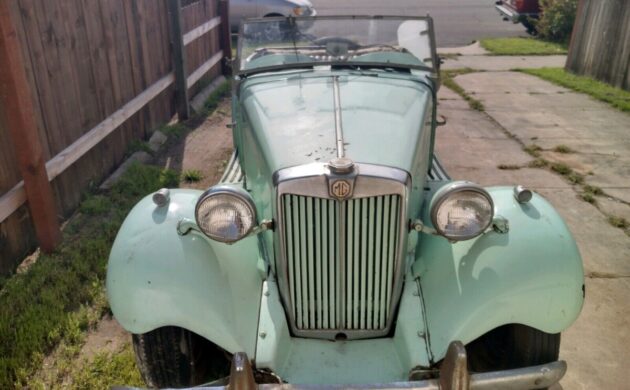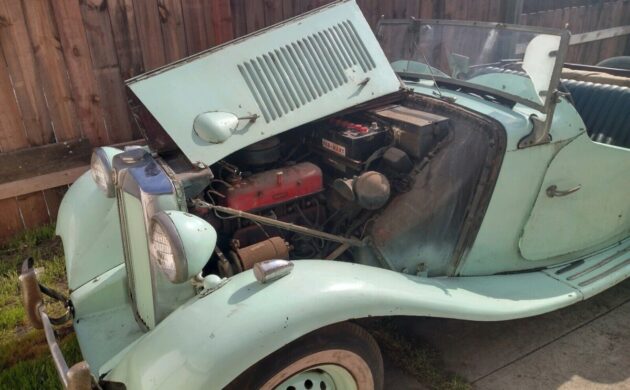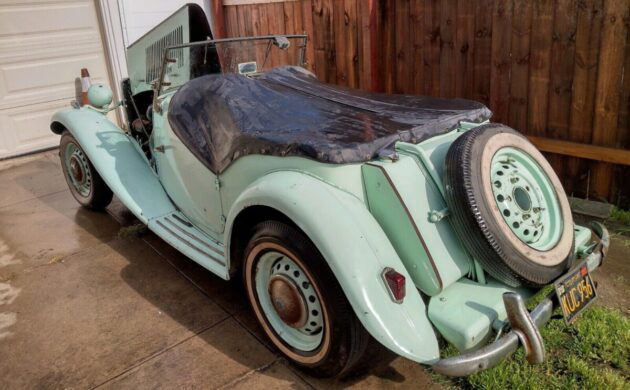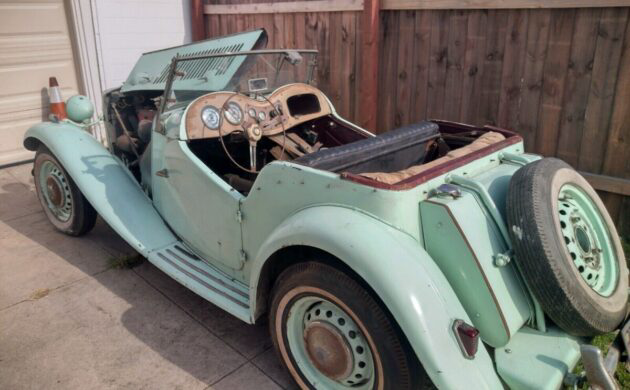This ad on eBay listing a 1952 MG TD contains one salient sentence: “The vehicle needs work.” So let’s go with that, and figure out exactly what it might take to resurrect this MG, and why you might want to run down to El Cajon, California to retrieve it. The seller wants a starting bid of $5,000 with no one willing yet, and his buy-it-now is $10,000. Is that expensive? In a word, yes. After several years of gently declining in price, nice TDs that are capable of scampering down the lane immediately can be had for around $20k these days. Unless you are handy with a wrench, torch, paint gun, and so forth, project TDs are a losing proposition – moneywise. Ah yes, but who doesn’t love that hound-like countenance, and the prospect of pip-pipping rakishly about in the car that made America love sports cars? … That is, provided you fit in it at all? Excellent query!
The TD was a disappointment to British drivers who loved the TC. Many complained that the comfort supplied by its independent suspension, rack and pinion steering, and increased width detracted from the “sporting” feel. The budget-driven switch from wire wheels to pressed steel was also reviled. But Americans loved it, at least partially because compared to the narrow confines of the TC and its right-hand-drive-only configuration, the TD was more usable. Rebuilding this one might start with its 1250 cc in-line four-cylinder motor. Fortunately, parts are, if not plentiful, at least possible. And its twin SU carburetors are ubiquitous; SU itself will sell you parts. After resurrecting the entire lump, you will be rewarded with about 50 hp, which sounds modest but considering that you will be sitting inches off the road in a car that shakes like a wet dog over every pebble, it’s enough. Gearchanges are achieved with a three-synchro four-speed manual, the first gear of which is nearly useless.
This car does come with that ancient security device – a tonneau – which though it looks like something from Home Depot, does fit. Perhaps the convertible top is back there somewhere, but no matter: see “rain” below. All lights and trim appear to be present. The car’s body is straight, and at least from the photos supplied, rust is not evident. Still, the floors, engine bay, joins between the body panels, and chassis bear close inspection. Hopefully, the new buyer can live with the color if the body proves sound, because leaving all that intact will save a bundle.
None of the photos give much detail. This one vaguely shows the interior, but all it reveals is some missing switches below the ignition in the dash, and that the steering wheel needs to be replaced or restored with a proper rim. Add to that new tires, repair or replacement of the wiring harness, rebuilding the gauges, maybe seat covers, and the brakes…. You know the drill. The car is complete, but it’s not going to put itself into driving condition. Oh, good news: You can skip fixing that windshield wiper box. If you drive in the rain you might drown or run into something, so just don’t. Well, there’s one more bit of good news: these are easy cars to work on, with plenty of club support and parts availability. So if you’re keen on a summer project, maybe the $5000 price is tolerable. What do you think?





Having owned a ’53 for a few years I can tell you that I wouldn’t buy this car that needs everything as compared to the 15K to 20K you can spend on one that doesn’t need anything.
Missed the part about the transmission’s first gear being worthless. It isn’t synchronized but using your second gear to start and stop through town will not give you a great clutch life.
“Nearly” worthless. Of course to start up from a stop, but you aren’t going to use it much after that.
Teach yourself to double-clutch back to first when on the move!
I used to go back to first in my Y-type from around 10 MPH. Great!!
The body looks pretty good and the engine and trim appears to be all there. I think if you could get it for something in the $5,000 range it’s attractive.
Is that a stock color? I don’t recall seeing it on one before.
For so many years these were ubiquitous in SoCal and not highly regarded. I suspect it wears one of Earl Scheib’s upgraded paint jobs over his famous $29.95 special. Maybe a deluxe $49.95 as it appears parts were actually masked off!
I see this as a good project for a DIY-type with tools and a large enough budget to buy the parts it needs. It’s overpriced, but a solid reduction to (as MattR says) half- or three-quarter-price would make it inviting.
You might not score a huge profit at resale time even if you do all the work yourself, but that’s not (or shouldn’t be) the point of a car like this. Concentrate on the fun-to-work-on and fun-to-drive aspects, and it’s a winner.
I’m 80YO now. Wish this had been available 20 years ago.
I’d say this looks like a better starting point
https://www.ebay.com/itm/285216112062?mkcid=16&mkevt=1&mkrid=711-127632-2357-0&ssspo=FiCryv0_QI6&sssrc=2349624&ssuid=HQk14jIIQmm&var=&widget_ver=artemis&media=COPY
Your find is miles ahead. Definitely a good deal.
For sure.
@LD71 that car is a world away from this one. Definitely would spend 15K before I would spend 5K on that project.
I was born in 1953 and am looking for a ‘53. BTW, I just tuned 70- not 80.
Why gas-chamber green? Ugh.
I guess if you roll through stop signs, or have no idea how to double clutch first gear is useless, but other than that bobhess is absolutely right. I have owned a ’49 TC, ’59 A, and ’68 Midget; none had (or ever had) synchro in 1st.
That was not what I was referring to. MG TD forums are full of folks complaining about the uselessness of first gear. I have an earlier MG PA and its first gear is worth about 20 feet before I have to change up. Here’s just one discussion:
http://www.mg-cars.net/mgtd-mgtf1500-bbs/differential-conversion-2012092513063918655.htm
Substantial discussion is available, too, about swapping to an MGA rear end, though that can prove problematic.
Regarding the comment about whitworth tools. I work on plenty of British cars, and it’s very rare that I need a whitworth anything – metric sometimes, yes. And as someone pointed out, whitworth tools are available, anyway, if you need them.
The bugaboo that no one mentions is that the bodies have wood frame that is prone to rot, so you also in many cases have to be a carpenter as well. I almost purchased a TD back in the early 1990s as a broke, but car crazy kid in my early 20’s. I was working for a parts store that specialized in parts for older British and European cars, so cheap orphan cars that I could tinker on to get running, play with for a bit and then sell them on at a very modest profit came my way all the time. This one had an early Volvo Amazon engine swap in it, so it was cheap. However when I went to look at it the doors sagged badly and it didn’t pass the icepick test, so I passed because there was no way I could stabalize the body with all the rot in the wood frame.
Buyer beware. As folks have said, the demand, and therefore prices of TDs have dropped to where you can get a decent driver that is sound in the $15-20K range. I would run the other direction from this one unless it was something like $2500-3000.
Replacement wood is available. It doesn’t have an on the moon price but it’s not the cheapest part of a rebuild on a TD.
Right. But no one had mentioned it. It is just something else to factor into the labor and cost of the rebuild, which makes $10K or even $5K for the project seem pretty steep. But with 0 feedback and very little good information, I’m not sure the seller really knows about TDs.
The reason I will not attempt an early British vehicle that will probably need wrenching is the fact that I have two old English motorcycles that I have given up on due to the fact that I can’t find wrenches that will fit, British Standard I was told, but they don’t always fit, Whitworth sometimes, ??? I’m 86 yo and would love to work on these old English vehicles if I could only find proper fitting wrenches!!!
There are universal sockets and end wrenches that automatically adapt to any size nut.
George, I’ve got a 1953 Triumph Thunderbird motorcycle, and I’ve never had any issues buying British “whitworth” wrenches (in quotes, because whitworth is a catch-all term when there are really a number of British thread types involved. British Standard Cycle (BSC) thread, and British Standard Fine (BSF). The confusion arises because BSC and BSF both have bolt head sizes which use Whitworth wrenches.)
Any place that is a parts source for vintage British motorcycles will also carry wrenches. You can also add to this by looking for the factory wrenches for the toolkits on eBay and so forth.
With a little digging and not a ton of effort you can put together the tools you need for your bikes. I absolutely would not use adjustable wrenches on that stuff- a good way to round off heads, and it’s not like you can go down to the hardware store and buy a replacement bolt.
The caveat is what you consider an old British motorcycle. Anything before 1969 with have the British fasteners. From 1969-on BSA and Triumph converted to American fine and course threads for external bolts, while engine and trans internal parts continued to use British fasteners. Norton never did convert over. In the original British motorcycle era, they did not use metric bolts and screws.